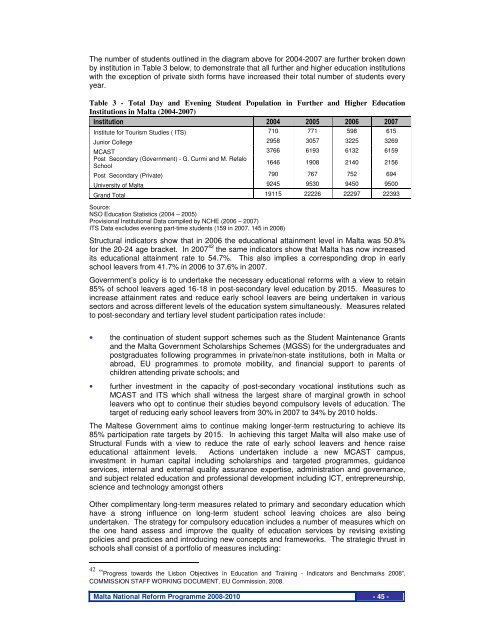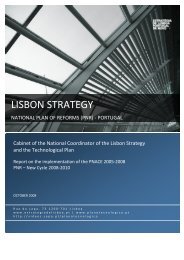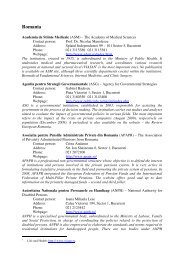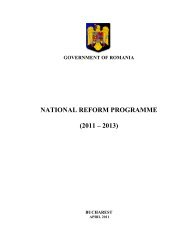National reform programme 2008-2010 Malta - European Commission
National reform programme 2008-2010 Malta - European Commission
National reform programme 2008-2010 Malta - European Commission
You also want an ePaper? Increase the reach of your titles
YUMPU automatically turns print PDFs into web optimized ePapers that Google loves.
The number of students outlined in the diagram above for 2004-2007 are further broken down<br />
by institution in Table 3 below, to demonstrate that all further and higher education institutions<br />
with the exception of private sixth forms have increased their total number of students every<br />
year.<br />
Table 3 - Total Day and Evening Student Population in Further and Higher Education<br />
Institutions in <strong>Malta</strong> (2004-2007)<br />
Institution 2004 2005 2006 2007<br />
Institute for Tourism Studies ( ITS) 710 771 598 615<br />
Junior College 2958 3057 3225 3269<br />
MCAST 3766 6193 6132 6159<br />
Post Secondary (Government) - G. Curmi and M. Refalo<br />
School<br />
1646 1908 2140 2156<br />
Post Secondary (Private) 790 767 752 694<br />
University of <strong>Malta</strong> 9245 9530 9450 9500<br />
Grand Total 19115 22226 22297 22393<br />
Source:<br />
NSO Education Statistics (2004 – 2005)<br />
Provisional Institutional Data compiled by NCHE (2006 – 2007)<br />
ITS Data excludes evening part-time students (159 in 2007, 145 in <strong>2008</strong>)<br />
Structural indicators show that in 2006 the educational attainment level in <strong>Malta</strong> was 50.8%<br />
for the 20-24 age bracket. In 2007 42 the same indicators show that <strong>Malta</strong> has now increased<br />
its educational attainment rate to 54.7%. This also implies a corresponding drop in early<br />
school leavers from 41.7% in 2006 to 37.6% in 2007.<br />
Government’s policy is to undertake the necessary educational <strong>reform</strong>s with a view to retain<br />
85% of school leavers aged 16-18 in post-secondary level education by 2015. Measures to<br />
increase attainment rates and reduce early school leavers are being undertaken in various<br />
sectors and across different levels of the education system simultaneously. Measures related<br />
to post-secondary and tertiary level student participation rates include:<br />
• the continuation of student support schemes such as the Student Maintenance Grants<br />
and the <strong>Malta</strong> Government Scholarships Schemes (MGSS) for the undergraduates and<br />
postgraduates following <strong>programme</strong>s in private/non-state institutions, both in <strong>Malta</strong> or<br />
abroad, EU <strong>programme</strong>s to promote mobility, and financial support to parents of<br />
children attending private schools; and<br />
• further investment in the capacity of post-secondary vocational institutions such as<br />
MCAST and ITS which shall witness the largest share of marginal growth in school<br />
leavers who opt to continue their studies beyond compulsory levels of education. The<br />
target of reducing early school leavers from 30% in 2007 to 34% by <strong>2010</strong> holds.<br />
The Maltese Government aims to continue making longer-term restructuring to achieve its<br />
85% participation rate targets by 2015. In achieving this target <strong>Malta</strong> will also make use of<br />
Structural Funds with a view to reduce the rate of early school leavers and hence raise<br />
educational attainment levels. Actions undertaken include a new MCAST campus,<br />
investment in human capital including scholarships and targeted <strong>programme</strong>s, guidance<br />
services, internal and external quality assurance expertise, administration and governance,<br />
and subject related education and professional development including ICT, entrepreneurship,<br />
science and technology amongst others<br />
Other complimentary long-term measures related to primary and secondary education which<br />
have a strong influence on long-term student school leaving choices are also being<br />
undertaken. The strategy for compulsory education includes a number of measures which on<br />
the one hand assess and improve the quality of education services by revising existing<br />
policies and practices and introducing new concepts and frameworks. The strategic thrust in<br />
schools shall consist of a portfolio of measures including:<br />
42 “Progress towards the Lisbon Objectives in Education and Training - Indicators and Benchmarks <strong>2008</strong>”,<br />
COMMISSION STAFF WORKING DOCUMENT, EU <strong>Commission</strong>, <strong>2008</strong>.<br />
<strong>Malta</strong> <strong>National</strong> Reform Programme <strong>2008</strong>-<strong>2010</strong> - 45 -







